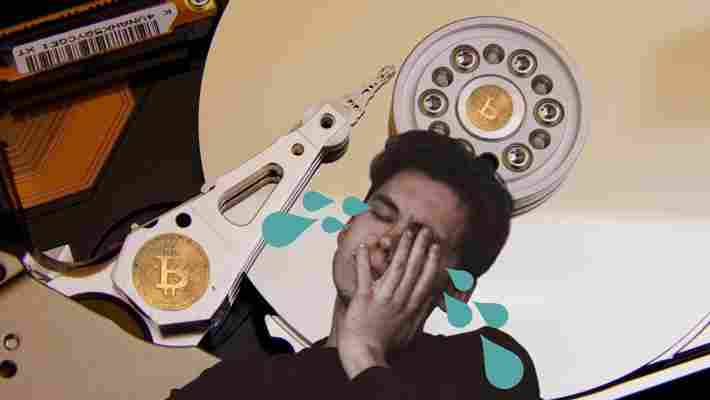Just yesterday we told you how there was a new Faketoshi in town, staking a questionable claim to the Bitcoin throne in a three-part blog series.

Last night saw the release of parts two and three , where Faketoshi deep dives into his alleged creation of Bitcoin, explains why he is unable to move Satoshi Nakamoto’s coins, and reveals his real identity.
But we still don’t buy it, and here’s why.
A questionable name change
In the blog posts, Faketoshi says his birth name was Bilal Khalid, but notes this was changed by deed poll to James Bilal Caan after seeing James Khan on BBC’s Dragon’s Den (a popular TV show in the UK).
“After the creation of Bitcoin and having chosen the alias name of Satoshi Nakamoto , thanks in part to Hal Finney, I was watching the movie The Godfather when I saw James Caan,” Faketoshi explains, “It was at that moment I thought, ‘I am the godfather of digital cash ’.”
“I also saw UK serial entrepreneur James Caan on the BBC series Dragon’s Den. I realized I could relate to him in that he was an Asian who had also changed his name, which is very uncommon. And the Dragon’s name reminded me of my mom calling me James and Khan,” he adds.
He says he shared his thoughts about changing his name with his wife, but that she insisted he kept his original name, too.
So, we are to believe that Satoshi Nakamoto, the creator(s) of Bitcoin – arguably one of the most influential peer-to-peer networks known to humankind – changed his name after being inspired by a BBC Dragon?
Surely someone with such technological prowess would be less swayable to make what seems like a childish, and random, life-changing decision? Maybe not.
Satoshi’s coins
As the quest to reveal Nakamoto’s identity has picked up pace over the years, the one bit of proof that would help identify the real creator(s) has remained the same.
Bitcoin‘s real creator owns a sizeable fortune: 980,000 BTC or $ 10.4billion according to today’s exchange rate.
These coins can only be controlled by Nakamoto, which would mean that if Caan really was who he claims to be, he’d be able to move the coins.
But think again because Caan conveniently explains he lost the hard drive containing his Bitcoin holdings when he sent a laptop for repair several years ago.
Although we have to commend Caan’s (if that’s his real name) efforts for attempting to deceive us with this laughable explanation, it all falls short.


In my eyes, whoever created Bitcoin is nothing short of genius, and while we are all human and make mistakes, I struggle to believe Nakamoto would have made such a basic error.
Caan says he’s embarrassed by this and claims it’s the reason why left the Bitcoin world.
However, losing the one thing that could grant undeniable proof that he is Satoshi all seems a bit convenient, don’t you think?
Satoshi is…religious?
In his latest blog post, Caan says he is “an avid lover of numerology and astrology, I use both in my day-to-day life. I do believe God is the ultimate mathematician, as everything around us can be viewed as numbers.”
Bitcoin, some would say, is the result of pure mathematical and cryptography genius and I have a hard time coming to terms that someone who fervently believes in numbers (and facts!) would have such strong religious beliefs.
“When I was working on the idea of Bitcoin, numbers were sending me strong signals. My names, email addresses, dates of domain registration – everything is connected to numbers. One or two encryptions may be seen as [a] coincidence, but not the full list,” he adds.
Faketoshi’s insistence to link Bitcoin’s creation to divine intervention seems, well, a little lazy.
And he’s got a new project shitcoin?
Just when we thought Caan couldn’t lack any more credibility, he brings up “AnnurcaCoin,” a project he claims is the world’s first centralized cryptocurrency and blockchain framework.
“I was working on the next phase of Bitcoin and Blockchain that again I hoped would transform the world,” he adds.
Now, I don’t know about you, but this seems rather suspicious.
Here is someone claiming to have created Bitcoin, undoubtedly the world’s most famous cryptocurrency, and instead of revealing unseen proof and details, he uses his 15 minutes of fame to promote a separate “project.”
Opportunistic, much?
A fake photo?
If you make it to the end of Caan’s lengthy post, you’ll be met with a suspicious-looking photograph purportedly of him.
I’m no photo expert, but I’d bet my Bitcoin that this is a clear example of an AI-generated image.
For starters, the photograph is placed against a plain background. This could be an attempt to remove any identifiable details, but it’s also a safe way to avoid any obvious fails (background distortion, indecipherable text, etc).
On closer inspection, the edges of Caan’s jacket look blurry and overexposed, to the point where one wonders if the image is juxtaposed on itself.
Now, let’s look at Caan’s glasses. Are they even real?
The glasses seem to be oddly placed. If you look closely, on the right of his face, you’ll see how the glasses simply stop in-line with his face.
Do you need any more proof that we are witnessing yet another Faketoshi emerging from the ashes?
I’m not quite sure what the end-goal of this media circus is, what Caan hopes to achieve (aside from flogging his shitcoin), or what the alleged PR firm working for him hopes will come out of all of this.
But I like to think the real Nakamoto is watching and cringing in despair.
Our robot colleague Satoshi Nakaboto never claimed he invented Bitcoin, but since he writes about it every fucking day, he just might have.
Binance to launch a blockchain for fiat-backed stablecoins, but who even cares?
Cryptocurrency exchange Binance has announced the launch of a new blockchain and it’s called project “Venus.” I’m not sure why it chose that name because Venus has no moons. Sad.

In an announcement published this morning , Binance described Venus as an “initiative to develop localized stablecoins and digital assets pegged to fiat currencies across the globe.”
Binance wants to create partnerships with governments, corporations, tech companies, to help countries offer new types of currency based on its new blockchain.
You’d be forgiven if parts of that sounded familiar. Facebook is currently working on its own digital currency called Libra , it too plans to work with other large tech companies to offer the coin but has so far faced tough feedback from governments .
But unlike Facebook, it sounds like Binance will be seeking support from governments much earlier than the social media giant.
Beyond the announcement, specific details about Binance‘s open blockchain remain sparse.
The exchange did point out that it’s been offering fiat-pegged stablecoins since last April, including one pegged to the value of the British Pound.
Now, let’s think about this with some context.
Binance has gone from being a nobody to one of the world’s biggest cryptocurrency exchanges in less than three years. Growth is good, continued growth is better.
Stablecoins are often touted as trading tools that help traders weather markets by being able to cash in and out of trades quickly. As the coins track the value of fiat, they’re generally less volatile than regular cryptocurrencies.
The cryptocurrency exchange also has Binance Coin (BNB), its own proprietary trading token. Users of the exchange can pay fees and trade other cryptocurrencies using BNB, it serves as an on-ramp to get and keep traders in the Binance ecosystem.
With all that in mind, it’s probably fair to assume that project Venus is a growth tool for Binance. By creating government backed stablecoins all over the world, Binance could in fact be creating regulated on-ramps to its more traditional exchange offerings.
Unless retail outlets start accepting project Venus-based tokens, it’s likely it’ll be just another platform for speculative investments.
It’s unlikely anything will come from this, I’m not excited about project Venus.
Twitter’s cryptocurrency scam bots are back with a fresh new look
Cryptocurrency in 2019 has been missing one key ingredient, Ethereum scambots on Twitter . The good news is: they’re back!

Those pesky fraudsters are up to their usual shenanigans, but this time they’ve been given a fancy makeover (new year, new do?), complete with an impressively modern design.
While it’s certainly a new look (an example of an old design is below), it’s pretty much the same modus operandi as last year: lure unsuspecting Twitter users to a really dodgy website under the guise of a free Ethereum giveaway.
This incarnation directs victims to a domain that claims to be handing out 2,000 ETH for free, particularly to those who “verify their Ethereum address” by sending cryptocurrency to a specific wallet address, presumably controlled by the scammers themselves.


The ruse is that any Ethereum sent to the address will be returned, doubled, almost instantly. It also has a perpetually “updating” spreadsheet of phony transactions that are meant to serve as proof of legitmacy.
Checking out the address provided in an Ethereum block explorer, we can easily see (at print time) nothing in it whatsoever , and no transactions have flowed through it up until this point (let’s hope it stays that way).
These bots indeed have a long history . What started as pretty basic impersonations of Ethereum‘s co-founder Vitalik Buterin eventually became a fully-fledged campaign to assume the identity of Elon Musk .
This led to a who’s-who of cryptocurrency to include ‘not giving away ETH’ in their social media handles, and Twitter was forced to attempt new rules in order to keep verified check marks out of the hands of imposters.
While some might rue the new-and-improved Ethereum scambots, others might say this is the ultimate buy signal. No, but seriously: Never send your Ethereum (or any cryptocurrency for that matter) to random addresses just because they asked you to.











